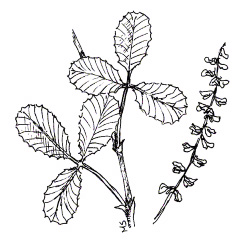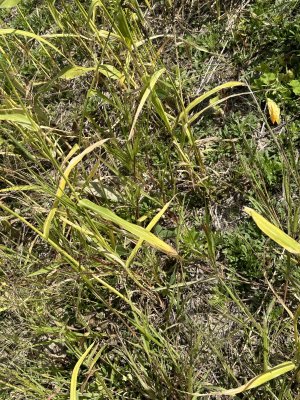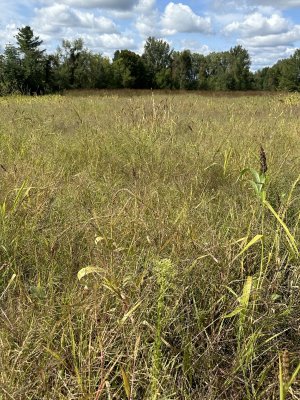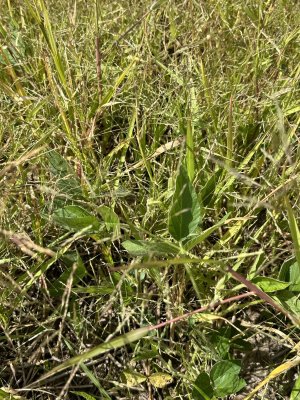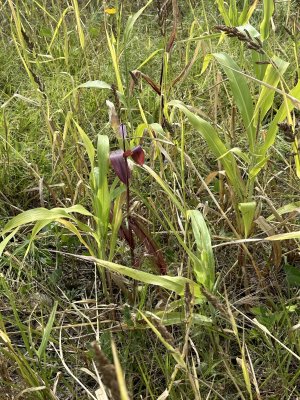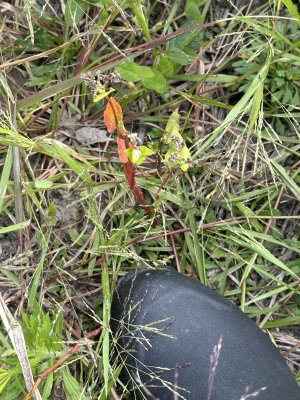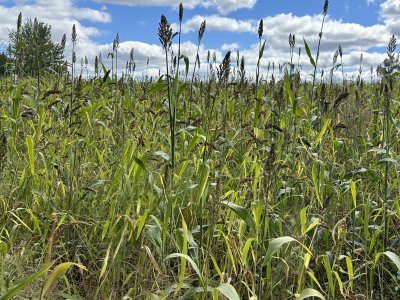farmlegend
5 year old buck +
2024 marked year three of my multi-species cover crop commitment at my farm in southern Michigan. It has been an interesting journey which I plan on continuing as long as I can. My goal in this is to improve the soil and also provide some deer food.
There are two plots involved in this, separated by a nice, wide brushy fencerow, and they total roughly nine acres. The ground was previously intensively tilled rowcrop ground for several successive decades, and, as such, the soil was quite depleted. Soil texture is clayish, which, I feel, adds to my challenge of enhancing my soil biology. While it was in rowcrops(corn/soybean rotation), the farmer combatted compaction by chiseling and discing it twice a year. Another limitation is my growing season is somewhat shorter that what some might expect for my latitude, about 15 miles north of the Ohio line – I average about 150 frost free days, with average last spring frost around May 8 and first autumn frost around October 5. The plots have woods on one side, and a shortgrass prairie(grasses, forbs) which I also planted in 2022 and is looking excellent this season, on the other three.
This year, I drilled in a mix of 18 different seeds on June 12. In descending order of pounds of seed per acre, the mix included:
Black beans
Soybeans, non-GMO
Cowpeas, Iron & Clay
Buckwheat
Corn, grazing
Millet, Japanese
Safflower, baldy
Kale, Bayou
Sunflower, Black oil
Sorghum, Forage
Sorghum, Sweet cane
Kale, Siberian
Turnips, purple top
Turnips, barkant
Flax
Arugula
Radish
Swede
For all but the last four seeds listed, mix was from utilizing Greencover’s “plotbuilder” program, drilled in at the prescribed 32#/acre. The last four were added by me, at a rate of about 1#/a each.
Planting timing and conditions were excellent, I felt. Timing of planting is generally dictated by how wet the dirt is, and the ground’s readiness can be as early as mid-May with a dry spring, until late June(as it was in 2022, the first year of the cover crop project, and the year it performed best. 2023 was adversely affected by severe drought).
I got rain immediately after planting this spring, and was enthused when seedlings popped up quickly, but things went downhill from there. Over the first sixty days, my farm got 21 inches of rain, over half of which came down in three individual events. Pure mud and ponding all over. Many of the plants survived, but were highly stressed, stunted, hard to find, and look terrible – like the buckwheat, corn, and all of the brassicas. Several never showed up, period - the sunflowers, flax, safflower, and swede never made an appearance at all. May of the plants that did show up are less abundant and robust than they were in prior years, including the beans, peas, and sorghums. Only two things appear to be really thriving – the Japanese millet, which came in everywhere, and invading coolseason grasses, my number one foodplot nemesis.
If you look at the plot from a distance today, it is tall, green, and robust looking, dominated by the millet, invading grasses, and sorghums. The pic was taken 8/10, about four weeks ago. It’s taller and thicker now. You can see some exposed dirt in the foreground in the pic below.
On Labor Day weekend I overseeded (via simple broadcasting) cereal grains and some plantain, crimson clover, turnips and radishes.
At this point, I haven’t made the headway I’d hoped for in combatting soil compaction and poor infiltration. We’ve had a dry spell recently and dirt remains quite tight across most of the plots. Also disappointed that so many plants simply failed this year.
As of now, I’m planning on planting another mix next spring, probably simply Greencover’s Summer release.
I welcome and appreciate any comments as to how I might make some improvements to enhance the performance of these plots in future seasons. And I apologize in advance for brief lags in my response time, as I am frequently away from my desktop for a couple days at a time this time of year, and I can’t stand keying in text from my phone.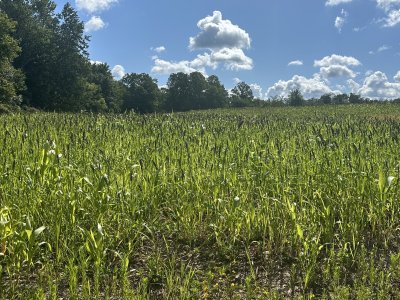
There are two plots involved in this, separated by a nice, wide brushy fencerow, and they total roughly nine acres. The ground was previously intensively tilled rowcrop ground for several successive decades, and, as such, the soil was quite depleted. Soil texture is clayish, which, I feel, adds to my challenge of enhancing my soil biology. While it was in rowcrops(corn/soybean rotation), the farmer combatted compaction by chiseling and discing it twice a year. Another limitation is my growing season is somewhat shorter that what some might expect for my latitude, about 15 miles north of the Ohio line – I average about 150 frost free days, with average last spring frost around May 8 and first autumn frost around October 5. The plots have woods on one side, and a shortgrass prairie(grasses, forbs) which I also planted in 2022 and is looking excellent this season, on the other three.
This year, I drilled in a mix of 18 different seeds on June 12. In descending order of pounds of seed per acre, the mix included:
Black beans
Soybeans, non-GMO
Cowpeas, Iron & Clay
Buckwheat
Corn, grazing
Millet, Japanese
Safflower, baldy
Kale, Bayou
Sunflower, Black oil
Sorghum, Forage
Sorghum, Sweet cane
Kale, Siberian
Turnips, purple top
Turnips, barkant
Flax
Arugula
Radish
Swede
For all but the last four seeds listed, mix was from utilizing Greencover’s “plotbuilder” program, drilled in at the prescribed 32#/acre. The last four were added by me, at a rate of about 1#/a each.
Planting timing and conditions were excellent, I felt. Timing of planting is generally dictated by how wet the dirt is, and the ground’s readiness can be as early as mid-May with a dry spring, until late June(as it was in 2022, the first year of the cover crop project, and the year it performed best. 2023 was adversely affected by severe drought).
I got rain immediately after planting this spring, and was enthused when seedlings popped up quickly, but things went downhill from there. Over the first sixty days, my farm got 21 inches of rain, over half of which came down in three individual events. Pure mud and ponding all over. Many of the plants survived, but were highly stressed, stunted, hard to find, and look terrible – like the buckwheat, corn, and all of the brassicas. Several never showed up, period - the sunflowers, flax, safflower, and swede never made an appearance at all. May of the plants that did show up are less abundant and robust than they were in prior years, including the beans, peas, and sorghums. Only two things appear to be really thriving – the Japanese millet, which came in everywhere, and invading coolseason grasses, my number one foodplot nemesis.
If you look at the plot from a distance today, it is tall, green, and robust looking, dominated by the millet, invading grasses, and sorghums. The pic was taken 8/10, about four weeks ago. It’s taller and thicker now. You can see some exposed dirt in the foreground in the pic below.
On Labor Day weekend I overseeded (via simple broadcasting) cereal grains and some plantain, crimson clover, turnips and radishes.
At this point, I haven’t made the headway I’d hoped for in combatting soil compaction and poor infiltration. We’ve had a dry spell recently and dirt remains quite tight across most of the plots. Also disappointed that so many plants simply failed this year.
As of now, I’m planning on planting another mix next spring, probably simply Greencover’s Summer release.
I welcome and appreciate any comments as to how I might make some improvements to enhance the performance of these plots in future seasons. And I apologize in advance for brief lags in my response time, as I am frequently away from my desktop for a couple days at a time this time of year, and I can’t stand keying in text from my phone.



